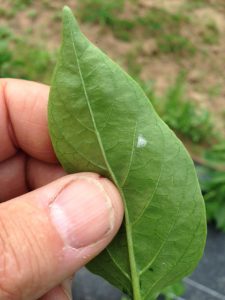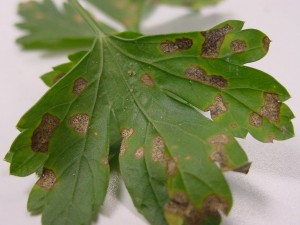- Downy mildew was confirmed on pea last week. The cool, damp weather the past week has been ideal for downy mildew development on spring crops.
- Soft rot, caused by Pectobacterium spp., was detected on planted potato seed last week in southern New Jersey.
- Bacterial leaf spot in romaine lettuce was found in the past week.
- The heavy rains and damp, cool weather have been ideal conditions for early-season damping off caused by Pythium and Phytophthora as well as downy mildew development on spring greens. Growers should continue to scout on a regular basis and remain proactive in their fungicide programs as long as current weather patterns continue.
- Cucurbit downy mildew has been reported on cucumber as far north as central North Carolina this week.
- No Late blight has been reported in region to date.
Vegetable Crops Edition
Seasonal updates and alerts on insects, diseases, and weeds impacting vegetable crops. New Jersey Commercial Vegetable Production Recommendations updates between annual publication issues are included.
Subscriptions are available via EMAIL and RSS.
Quick Links:
 NJ Commercial Vegetable Production Recommendations
NJ Commercial Vegetable Production Recommendations
 Rutgers Weather Forecasting - Meteorological Information important to commercial agriculture.
Rutgers Weather Forecasting - Meteorological Information important to commercial agriculture.
Vegetable Disease Update – 5/30/18
IPM Update 5/23/18
Sweet Corn
 The black light trap network is nearly complete at this time. To date, no corn earworm (CEW) have been captured. Increasing numbers of European corn borer (ECB) moths have been captured this past week, although numbers are still quite low. At present, the highest activity is in portions of northern Burlington and northwestern Ocean counties (see ECB map). This pest poses little threat at this time, as the earliest sweet corn plants are only just reaching suitable size to support larvae.
The black light trap network is nearly complete at this time. To date, no corn earworm (CEW) have been captured. Increasing numbers of European corn borer (ECB) moths have been captured this past week, although numbers are still quite low. At present, the highest activity is in portions of northern Burlington and northwestern Ocean counties (see ECB map). This pest poses little threat at this time, as the earliest sweet corn plants are only just reaching suitable size to support larvae.
The highest nightly trap catches of ECB for the week ending 5/23/18 are as follows:
| Allentown 1 | Dayton 1 | New Egypt 1 |
| Centerton 1 | Jobstown 1 | |
| Croswicks 1 | Medford 1 |
IPM Update 5/16/18
Sweet Corn
IPM Program personnel are currently finishing deployment of the black light trap network in New Jersey. At present, we are approximately 70% operational and have begun to monitor traps. To date, no corn earworm (CEW) have been captured. The low numbers of European corn borer (ECB) moths that have been caught do not allow us to produce a map image. As numbers increase, look for population maps of ECB, CEW and CEW catches from pheromone traps in this weekly publication.
The highest nightly trap catches of ECB for the week ending 5/15/18 are as follows:
Allentown 1 New Egypt 1
Crosswicks 1 Pennington 1

European corn borer egg mass on a pepper leaf.
Veg IPM Update: Allium leaf miner 04/30/18
Allium Leaf Miner
Allium leaf miner (ALM) adults (flies) were trapped on sticky cards, and moderate levels of feeding signs were discovered late last week at sites in Lawrenceville and Pennington (Mercer County). Additionally, volunteer garlic in the Chesterfield area of Burlington County was infested. As yet, no adult activity or feeding has been found at the more northern sites in Milford, Pittstown and Asbury (Hunterdon County). Affected crops include chives, scallions, garlic and leeks. Although we are 2-3 weeks behind last spring’s development, the ALM flight now seems to be well underway in parts of the state. With warm weather forecast for the remainder of this week, growers in the northernmost counties should expect infestations to occur there as well.
Floating row covers, kept on until the first flight ends will help minimize access to plants. Insecticide applications targeting adults may be helpful as well, although frequency of applications is uncertain. Spinosyn materials (Radiant, Entrust (OMRI approved)), pyrethroids (Mustang Maxx, Warrior), and pyrethrin materials (Pyganic (OMRI approved)), neonicotinoids (Scorpion, Venom) and the insect growth regulator Trigard are labeled for miner control.
Adult activity and observations of feeding will be reported on in the IPM Update as they occur. At this time, all growers should respond to the onset of the first adult generation. We will attempt to identify the end of the first flight so that growers know when the risk of infestation has abated.
Controlling Septoria Leaf Spot and Bacterial Leaf Blight in Parsley
Septoria leaf spot (SLS) in Parsley can cause significant losses in fields where it has become established. Like other Septoria’s, the leaf spots produced on parsley look much like the leaf spots produced on tomatoes and other crops. Septoria leaf spot overwinters from year to year on infected debris so long crop rotations of 2 or more years are important to help reduce disease pressure. During the season, SLS will spread rapidly with each subsequent rainfall and/or overhead irrigation event. Therefore, early detection and preventative fungicide applications are key to successfully controlling SLS. Unfortunately, very few fungicides are currently labeled making control difficult.

Septoria leaf spot of Parsley
Damping-off: Identifying and Controlling Early-Season Pathogens
It is extremely important to know which pathogen is causing damping-off problems and which fungicide to properly apply. The key to controlling damping-off is being proactive instead of reactive. Always refer to the fungicide label for crop use, pathogens controlled, and application rates.
Damping-off is caused by a number of important vegetable pathogens and is very common during the spring. Damping-off can kill seedlings before they break the soil line (pre-emergent damping-off) or kill seedlings soon after they emerge (post-emergent damping-off). Common pathogens that cause damping-off include Pythium, Phytophthora, Rhizoctonia and Fusarium spp.
Control of damping-off depends on a number of factors. First, is recognizing the conditions which may be leading to the problem (i.e., weather/greenhouse growing conditions) and second, identifying the pathogen causing the problem.
Conditions Favoring Damping-off
Although all four pathogens are associated with damping-off, the conditions which favor their development are very different. In general, Phytophthora and Pythium are more likely to cause damping-off in cool, wet or overwatered soils that aren’t allowed to dry out due to cloudy weather or cooler temperatures. Conversely, Rhizoctonia and Fusarium are more likely to cause damping-off under warmer, drier conditions especially if plug trays are kept on the dry side to help reduce transplant growth. [Read more…]
